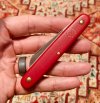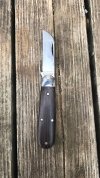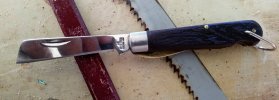I spent a lot of time staring at the photos of the old pocket knives of the steamship Arabia. Sunk in the middle of the 19th century, it was a time capsule of the mid 1800's as far as pocket knives go. Being buried in the mud for over a century did a very good job of preserving the knives, some looking like they could be put back into service today with a little oiling and a touch on a stone.
The one thing that stood out me was, the large numbers of sheep foot/wharncliff blades. The medium size single blade sheep foot seemed to be the most common with the spear point being right up there with it. I'm curious by nature, and being a hopeless romantic of the past, I decided on an experiment of my own.
I bought a Victoriox florist knife at a gun show for my own use. I dropped it in my pocket a few months ago and had been using as my main pocket knife. I was curious as to how the sheep foot would work out on an everyday basis. I do know that with my old Buck 301 stockman I carried for 25 years, the sheep foot was my most used blade for general cutting. The strait edge was very easy to sharpen, the blade has a strong yet fine point, and it humps up there so it's easy to pinch open.
It's been an eye opener. If I say sort of, it's only because it didn't surprise me how nice it was for an everyday carry pocket knife. I was using a Case mini copperhead for a while, so I wasn't too surprised. But the Victorinox was even nicer. The wider full flat blade came down to a very very fine edge that was a thin chisel grind. The final blade edge is so thin that it's like an Opinel, only without the fiddley do-it-yourself finishing that sort of works. The Victoriox florist knife is a slicer and dicer on par with a freshly sharpened Opinel, weather proof, built with real metal liners and nylon scales for a very rugged yet light weight unit. A unit that cuts like the dickens.
I've found the Victorinox sheep foot to be great for opening packages, cutting anything a regular pocket knife would be used for, and able to be scrubbed down in the kitchen sink with no problem. The thing to get used to is how fast the blade goes through stuff. Be careful to keep fingers out of the way. I whittled on some good hard dry Texas cedar with it and the edge held up good. Jute twine and cardboard were childs play for the knife. Breaking down a large cardboard box to fit in the recycle bin was like the proverbial knife through warm butter. A fresh bagel was easy.
One nice thing job the slip joint with a sheep foot; if you have to press down with the point to make a starter hole for a wood screw, or pierce a plastic package or seal of some sort, the fact of the knife being held at a 45 degree angle to bring the fine tip to play, puts pressure on the blade in the direction of the opening the blade so the dynamic forces keep the blade from closing as good as if it were a lock blade. Using the point on a sheepfoot/wharncliffe is easier and safer than a clip or spearpoint because of the Ange you us the point at. Maybe thats why they were so popular in the old day. The sheep foot blade on a pocket knife is actually way more versatile than you would think from it's shape. But maybe that's why our English cousins are so fond of the lambs foot knife that is almost a trademark of the British cutlery industry of the past. All those old British military clasp knives had the sheepsfoot blade they saw some very hard service for The Empire in some far flung harsh places.
I've been very impressed with this Victorinox florist, but then Victorinox makes a good product. It's even available is some choices of colors that can't get lost very easy in the woods or crowded work bench. I've got the standard red, but you can get yellow, pink, green, blue, and even purple. I'm going to California again in April, and I think the granddaughter is going to want one, and purple is a favorite color of hers. She's already got a Victorinox classic in purple, a Fenix E01 in purple. I think there may be a purple Victorinox florist in her future.
Oh, I found out that it opens up fish bellies very good on the San Gabriel river as well. Did I mention that it cuts like the dickens?
I just may have to get an old British clasp knife!
Jack Black mentioned this in a thread I forget the location of.








 Untitled
Untitled

